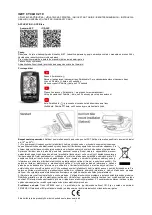
CS725 Snow Water Equivalent Sensor
7
TABLE 6-1.
Collimator Guidelines
Site Characteristics
Max SWE
< 300 mm
Max SWE
300 – 400 mm
Max SWE
> 400 mm
Very open with no proximity to
trees, buildings or vegetation
within 48 m (160 ft) radius
Optional
Optional
Optional
No trees, buildings or tall
vegetation within a 24 m (80 ft)
radius
Optional
Optional
Required
No trees, buildings or tall
vegetation within a 12 m (40 ft)
radius
Optional
Required
Required
Site with minimum clearance
radius of 6 m (20 ft) radius
Required
Required
Required
6.2.2 Soil Moisture
Soil moisture can influence SWE by attenuating the signal. Avoid low lying
areas where water pools or saturates the soil during the snow melt and bog type
ground conditions due to the potentially high moisture content. It will be
necessary to determine the soil moisture (aka: soil humidity) content of the site
in % by weight. This value is entered into the CS725 setup parameters. See
Appendix C Gravimetric Soil Moisture Method for detailed instructions on
how to determine soil moisture content.
6.2.3 Initial Site Evaluation
As there is naturally-occuring variability in radiation levels from site to site, it
is recommended to qualify the site prior to permanently installing the CS725.
Required equipment:
•
CS725 with accessories
•
Su12 Vdc power supply to run the CS725 for several hours
•
Mounting hardware to vertically suspend the CS725 over the ground
at the qualifying site. Note: for qualifying purposes the suspension
height is not critical (0.5-1 m is sufficient)
•
Laptop with suitable terminal emulator program (e.g. HyperTerminal)
Overview of steps:
•
Mount the CS725 as close as possible to desired permanent location
•
Avoid placing items underneath the CS725 during testing
•
For best results, mounting at 1 m or more above the ground
•
Install the collimator if available
Summary of Contents for CS725
Page 2: ......
Page 35: ......
Page 47: ......
Page 49: ...Appendix Title B 2 ...
Page 52: ...CS725 Snow Water Equivalent Sensor C 3 ...
Page 55: ......













































